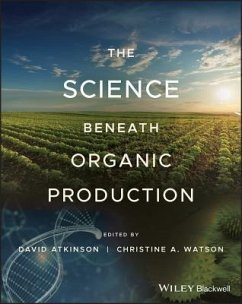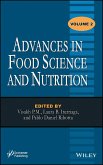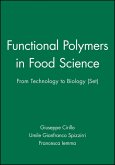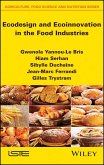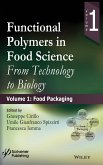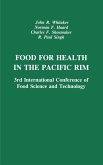The Science Beneath Organic Production
Herausgeber: Atkinson, David; Watson, Christine A
The Science Beneath Organic Production
Herausgeber: Atkinson, David; Watson, Christine A
- Broschiertes Buch
- Merkliste
- Auf die Merkliste
- Bewerten Bewerten
- Teilen
- Produkt teilen
- Produkterinnerung
- Produkterinnerung
A groundbreaking book that addresses the science that underpins organic agriculture and horticulture and its impact upon the management of organic systems With contributions from noted experts in the field, The Science Beneath Organic Production explores the cultural context of food production and examines the historical aspects, economic implications, and key scientific elements that underpin organic crop production. The book shows how a science-based approach to organic farming is grounded in history and elements of the social sciences as well as the more traditional areas of physics,…mehr
Andere Kunden interessierten sich auch für
![Viewpoints and Controversies in Sensory Science and Consumer Product Testing Viewpoints and Controversies in Sensory Science and Consumer Product Testing]() Howard R MoskowitzViewpoints and Controversies in Sensory Science and Consumer Product Testing246,99 €
Howard R MoskowitzViewpoints and Controversies in Sensory Science and Consumer Product Testing246,99 €![Advances in Food Science and Nutrition, Volume 2 Advances in Food Science and Nutrition, Volume 2]() Advances in Food Science and Nutrition, Volume 2211,99 €
Advances in Food Science and Nutrition, Volume 2211,99 €![Functional Polymers in Food Science Functional Polymers in Food Science]() Functional Polymers in Food Science385,99 €
Functional Polymers in Food Science385,99 €![EcoDesign and Ecoinnovation in the Food Industries EcoDesign and Ecoinnovation in the Food Industries]() Gwenola Yannou-Le BrisEcoDesign and Ecoinnovation in the Food Industries170,99 €
Gwenola Yannou-Le BrisEcoDesign and Ecoinnovation in the Food Industries170,99 €![Functional Polymers in Food Science Functional Polymers in Food Science]() Functional Polymers in Food Science208,99 €
Functional Polymers in Food Science208,99 €![Smart Packaging Technologies for Fast Moving Consumer Goods Smart Packaging Technologies for Fast Moving Consumer Goods]() Smart Packaging Technologies for Fast Moving Consumer Goods235,99 €
Smart Packaging Technologies for Fast Moving Consumer Goods235,99 €![Food for Health in the Pacific Rim Food for Health in the Pacific Rim]() Food for Health in the Pacific Rim176,99 €
Food for Health in the Pacific Rim176,99 €-
-
-
A groundbreaking book that addresses the science that underpins organic agriculture and horticulture and its impact upon the management of organic systems With contributions from noted experts in the field, The Science Beneath Organic Production explores the cultural context of food production and examines the historical aspects, economic implications, and key scientific elements that underpin organic crop production. The book shows how a science-based approach to organic farming is grounded in history and elements of the social sciences as well as the more traditional areas of physics, chemistry, and biology. The Science Beneath Organic Production offers a detailed explanation of the differences between organic systems and other approaches, answering questions about crop production and protection, crop rotations, soil health, biodiversity, and the use of genetic resources. The authors identify current gaps in our understanding of the topic and discuss how organic farming research may be better accomplished in the future. This important book: * Explores the science that underpins organic farming * Contains illustrative case studies from around the world * Examines organic agriculture's philosophical roots and its socio-economic context Written for scientists and students of agriculture and horticulture, this book covers the issues linked to the use of science by organic producers and identifies key elements in the production of food.
Hinweis: Dieser Artikel kann nur an eine deutsche Lieferadresse ausgeliefert werden.
Hinweis: Dieser Artikel kann nur an eine deutsche Lieferadresse ausgeliefert werden.
Produktdetails
- Produktdetails
- Verlag: Wiley
- Seitenzahl: 328
- Erscheinungstermin: 22. Juli 2019
- Englisch
- Abmessung: 246mm x 189mm x 9mm
- Gewicht: 621g
- ISBN-13: 9780470023938
- ISBN-10: 0470023937
- Artikelnr.: 43609797
- Herstellerkennzeichnung
- Libri GmbH
- Europaallee 1
- 36244 Bad Hersfeld
- gpsr@libri.de
- Verlag: Wiley
- Seitenzahl: 328
- Erscheinungstermin: 22. Juli 2019
- Englisch
- Abmessung: 246mm x 189mm x 9mm
- Gewicht: 621g
- ISBN-13: 9780470023938
- ISBN-10: 0470023937
- Artikelnr.: 43609797
- Herstellerkennzeichnung
- Libri GmbH
- Europaallee 1
- 36244 Bad Hersfeld
- gpsr@libri.de
ABOUT THE EDITORS DAVID ATKINSON was formerly Vice Principal at the Scottish Agricultural College and Chair of Falkland Rural Enterprises, an organic farming company. He continues to study the ethical implications of emerging biotechnologies. CHRISTINE A. WATSON leads soil science research at SRUC. She has extensive experience of research in organic farming and is involved in managing and teaching SRUC's postgraduate course in Organic Farming.
List of Contributors xi Preface xiii 1 Science and Organic Agriculture: An Introduction 1 David Atkinson and Christine A. Watson 1.1 What is the Role of this Volume? 1 1.2 What is Organic Agriculture? 2 1.3 So What is Distinctive About its Science Base? 5 1.4 The Ecological Roots of Organic Production 6 1.5 Key Elements in the Science Context of Organic Agriculture 8 1.6 Some Areas of Different Science 10 1.7 Production Systems Compared 13 1.8 A Science Base for All Production 15 1.9 The Changing Context of Farming 18 References 21 2 Science, Research and Organic Farming 25 Lawrence Woodward 2.1 Introduction 25 2.2 The Roots of the Approach 25 2.2.1 Is it a philosophical or political movement and cannot therefore be scientific? 26 2.2.2 Does it lack coherence except as a marketing exercise? 27 2.2.3 Is it inherently unscientific because it is based on concepts that are not explicable in rational scientific terms? 28 2.3 Agricultural Science: Some Reflections 30 2.4 Conclusion 32 References 32 3 Framing and Farming: Putting Organics in a Societal Context 33 Pete Ritchie 3.1 Introduction 33 3.2 The Origin of Organics 34 3.3 The Argument from Economics: Is More Better? 35 3.4 The Argument from the Environment: Externalities Matter 37 3.5 The Argument from Ethics: There's Something Wrong with the System 37 3.5.1 What is the Place of Humans in Nature? 38 3.5.2 What is Farming For, and What Makes for Good Farming? 40 3.5.3 How can the way we produce food promote social justice? 41 3.6 Aligning Organics with Social Justice 42 3.7 Conclusion 43 References 43 Further Reading 43 4 Soil Health and Its Management for Organic Farming 45 Elizabeth A. Stockdale, Tony C. Edwards and Christine A. Watson 4.1 Introduction 45 4.2 Soil Components 47 4.2.1 Soil Parent Material and Profile Formation 47 4.2.2 Soil Organic Matter 48 4.2.3 Soil Organisms 48 4.3 Key Soil Processes in Agricultural Systems 51 4.3.1 Decomposition 51 4.4 Soil Structure Formation and Stabilisation 53 4.5 Below
Ground Ecological Interactions 54 4.6 Nutrient Cycling and Management 56 4.6.1 Potassium (K) and Other Cations (Mg, Ca) 56 4.6.2 Nitrogen (N) 57 4.6.3 Phosphorus (P) 59 4.7 Impact of Agricultural Management Practices on Soil Function and Health 61 4.8 Cropping Systems 63 4.9 Intensive Grassland 65 4.10 Conclusion 66 References 68 5 Cropping Systems and Crop Choice 79 Robin L. Walker 5.1 Farming Systems 79 5.2 Land Capability and Cropping System Choice 81 5.2.1 Rainfall 81 5.2.2 Temperature 81 5.2.3 Altitude and Topography 82 5.2.4 Soil 83 5.2.5 Markets 83 5.2.6 Traditions 83 5.2.7 Government Policy 84 5.3 How Land Capability is Used in Practice 84 5.4 Conclusion 85 References 85 6 Crop Rotations: The Core of Organic Production 87 David Atkinson and Robin L. Walker 6.1 Introduction 87 6.2 The History of Crop Rotations 88 6.3 Rotations in Organic Production 91 6.4 The Ecological Science Base of Organic Production 94 6.5 Impact of Rotations on Soil Properties 95 6.5.1 Impact of Rotations on Soil Condition 95 6.5.2 Impact of Rotations on Nutrient Availability 98 6.5.3 Nitrogen Supply in Rotations 99 6.5.4 Phosphorus Supply in Rotations 100 6.6 Impact of Rotations on Crop Protection 103 6.7 Stockless Rotations 105 6.8 Conclusion 105 References 107 7 What Can Organic Farming Contribute to Biodiversity Restoration? 111 Ruth E. Feber, Paul J. Johnson and David W. Macdonald 7.1 Why Conserve Farmland Biodiversity? 111 7.2 What Can Organic Farming Contribute to Biodiversity Conservation? 116 7.3 Effects of Organic Farming Vary with Taxa 118 7.4 How Rapid is the Effect of Conversion to Organic on Biodiversity? 120 7.5 Landscape Context and Species Traits 121 7.6 Wider Considerations 123 Acknowledgements 126 References 126 8 Optimising Crop Production in Organic Systems 133 David Atkinson and Robin L. Walker 8.1 Introduction 133 8.2 Basic Issues 134 8.3 Light Interception: The Basis of All Production 136 8.3.1 Energy Capture 136 8.3.2 Canopy Duration 137 8.3.3 Stomatal Functioning 138 8.3.4 Crop Species 138 8.3.5 Crop Growth and Resource Partitioning 140 8.3.6 Soil
Related Factors 141 8.3.7 Consequences 142 8.4 What Current Issues Affect Choice of Crop Production System? 142 8.5 What Options Exist for Regulating Yields? 144 8.6 How Different are Conventional and Organic Yields? 145 8.7 The Environmental Impact of Organic Systems 147 8.8 Conclusion 148 References 148 9 Crop Production: Meeting the Nutrient Needs 151 David Atkinson and Robin L. Walker 9.1 Introduction 151 9.2 Getting Nutrients into Organic Crops 152 9.3 What is the Impact of Differences in Soil Nutrient Supply? 154 9.4 Organic Manures: Recycling of Nutrient Sources 155 9.5 Crop Rotations 157 9.6 Cover Crops 158 9.7 Legumes 158 9.8 Soil Microbial Populations and Inoculation 159 9.9 The Impact of Different Soil Nutrients 160 9.9.1 Nitrogen: How Much N Does a Crop Need? 160 9.9.2 Phosphorus 162 9.9.3 Potassium 163 9.9.4 Sulphur 164 9.10 Conclusion 164 References 165 10 Crop Attributes Facilitating the Use of Soil Resources 169 David Atkinson 10.1 Introduction 169 10.2 Nutrient Capture and Utilisation 171 10.2.1 Basic Issues 171 10.2.2 Nutrient Availability 172 10.3 The Functional Requirements of a Root System 172 10.3.1 Basic Issues 172 10.3.2 Relation of Root Activity to Soil Processes 172 10.3.3 The Impact of Root System Form 174 10.3.4 Variation Between Crop Species 175 10.3.5 Variation Within Crop Species 178 10.4 Case Studies 180 10.4.1 Case Study 1: Betula pendula 180 10.4.2 Case Study 2: Spring Barley 182 10.5 Root Dynamics and Carbon Inputs to the Soil 183 10.5.1 Root Dynamics 183 10.5.2 Root Longevity 184 10.6 Variation in Root Systems in Practice 185 10.6.1 Variation in Root Systems with Functional Significance 185 10.6.2 The Ability of the Crop Plant to Extract Nutrients from the Soil 188 10.7 Case Study 3: Apple 188 10.8 So How Much Root Does a Plant Need? 191 10.9 Conclusion 192 References 193 11 Mycorrhizal Activity, Resource and Microbial Cycles 199 David Atkinson 11.1 Introduction 199 11.2 Mycorrhizal Establishment 199 11.3 Mycorrhizal Effects 201 11.4 The AMF Association 202 11.5 Effects on Plant Nutrition: Basic Mechanisms 203 11.6 Impact on Crop Nutrition 204 11.7 The Impact of AMF on Soil Structure 204 11.8 Carbon Flows into the Soil 204 11.9 The Impact of AMF on Adaptation to the Soil Physical Environment 205 11.10 The Impact of AMF on Plant Pathogens 206 11.11 Impact of AMF on Roots 206 11.12 Arbuscular Mycorrhizal Fungi and the Management of Soils 209 11.13 Conclusions: AMF and Root Functioning 209 References 209 12 Crop Protection and Food Quality: Challenges and Answers 213 David Atkinson and Robin L. Walker 12.1 Introduction 213 12.2 Crop Protection Against Pests, Weeds and Diseases 214 12.3 Weed Control 215 12.4 Living with Crop Diseases 219 12.4.1 The Impact of AMF on Plant Pathogens 220 12.4.2 Plant Varietal
Based Resistance 222 12.5 Pest Control 224 12.6 The Quality of Organic Crops and Crop
Based Foods 226 12.6.1 Varietal Selection 227 12.6.2 The Production System 228 12.6.3 Inputs Used as Part of the Cultural System 228 12.6.4 Inherent Attributes 230 12.6.5 Microbial Content and Chemical Contamination 231 12.7 Conclusion 231 References 232 13 Plant Breeding and Genetics in Organic Agriculture 237 Thomas F. Döring and Martin S. Wolfe 13.1 Introduction 237 13.2 Plant Diversity in AgröEcosystems 238 13.2.1 Genetic Diversity 239 13.2.2 Species and Ecosystem Diversity 241 13.2.3 Effects of Crop Diversity: Types of Mechanisms 242 13.3 Crop Genetics in Complex and Dynamic Environments 244 13.3.1 The Organic Principle of Ecology 244 13.3.2 The Ecology of G × E Interactions 244 13.3.3 Implications of G × E Interactions for Testing Varieties for Organic Agriculture 245 13.3.4 Genetic Properties of Crops for Suitability in Organic Systems 248 13.3.5 Crop Genetics for Ecological Cropping Systems Design 249 13.3.6 Limitations of Crop Genetics and the Role of Plant Genetic Diversity 250 13.4 Crop Genetics for Health 250 13.4.1 The Organic Principle of Health 250 13.4.2 What is Health? 251 13.4.3 Connections Between Crop Genetics and Health 251 13.4.4 The Role of Plant Genetic Diversity for Health 256 13.5 Socioeconomics, Policies and Regulations 257 13.5.1 The Organic Principle of Fairness 257 13.5.2 Traditional Landraces and the Protection of Plant Genetic Resources 258 13.5.3 Sharing the Costs and Benefits of Plant Breeding 259 13.5.4 Hybrid Varieties in Organic Farming 259 13.6 Indeterminism and Crop Genetics 260 13.6.1 The Organic Principle of Care 260 13.6.2 Implications of the Care Principle for Crop Breeding 260 13.6.3 The Role of Plant Genetic Diversity for the Care Principle 261 13.7 Conclusion 261 References 262 14 Exploring the Systems Concept in Contemporary Organic Farming Research 273 Christine A. Watson and Bruce D. Pearce 14.1 Introduction 273 14.2 The Importance of the Systems Concept in Organic Farming 274 14.3 How are Systems Reflected in Regulation? 275 14.4 Applying the Systems Concept to Organic Production 275 14.5 How is the Systems Concept Reflected in Organic Farming Research? 277 14.5.1 Example 1. Comparison of Production Systems 280 14.5.2 Example 2. Food Quality and Its Relation to Production Systems 281 14.5.3 Example 3. Weed Control 282 14.5.4 Example 4. Plant Breeding 282 14.6 Cautionary Tales 283 14.7 Are the Research Needs of Organic Farming Different from Conventional Farming? 283 References 284 15 Science Base of Organic Agriculture: Some Conclusions 289 David Atkinson and Christine A. Watson 15.1 Introduction 289 15.2 Increasing the Contribution of Organic Agriculture to Global Food Production 291 15.3 Challenges to Organic Production 295 15.4 Conclusion 297 References 297 Index 299
Ground Ecological Interactions 54 4.6 Nutrient Cycling and Management 56 4.6.1 Potassium (K) and Other Cations (Mg, Ca) 56 4.6.2 Nitrogen (N) 57 4.6.3 Phosphorus (P) 59 4.7 Impact of Agricultural Management Practices on Soil Function and Health 61 4.8 Cropping Systems 63 4.9 Intensive Grassland 65 4.10 Conclusion 66 References 68 5 Cropping Systems and Crop Choice 79 Robin L. Walker 5.1 Farming Systems 79 5.2 Land Capability and Cropping System Choice 81 5.2.1 Rainfall 81 5.2.2 Temperature 81 5.2.3 Altitude and Topography 82 5.2.4 Soil 83 5.2.5 Markets 83 5.2.6 Traditions 83 5.2.7 Government Policy 84 5.3 How Land Capability is Used in Practice 84 5.4 Conclusion 85 References 85 6 Crop Rotations: The Core of Organic Production 87 David Atkinson and Robin L. Walker 6.1 Introduction 87 6.2 The History of Crop Rotations 88 6.3 Rotations in Organic Production 91 6.4 The Ecological Science Base of Organic Production 94 6.5 Impact of Rotations on Soil Properties 95 6.5.1 Impact of Rotations on Soil Condition 95 6.5.2 Impact of Rotations on Nutrient Availability 98 6.5.3 Nitrogen Supply in Rotations 99 6.5.4 Phosphorus Supply in Rotations 100 6.6 Impact of Rotations on Crop Protection 103 6.7 Stockless Rotations 105 6.8 Conclusion 105 References 107 7 What Can Organic Farming Contribute to Biodiversity Restoration? 111 Ruth E. Feber, Paul J. Johnson and David W. Macdonald 7.1 Why Conserve Farmland Biodiversity? 111 7.2 What Can Organic Farming Contribute to Biodiversity Conservation? 116 7.3 Effects of Organic Farming Vary with Taxa 118 7.4 How Rapid is the Effect of Conversion to Organic on Biodiversity? 120 7.5 Landscape Context and Species Traits 121 7.6 Wider Considerations 123 Acknowledgements 126 References 126 8 Optimising Crop Production in Organic Systems 133 David Atkinson and Robin L. Walker 8.1 Introduction 133 8.2 Basic Issues 134 8.3 Light Interception: The Basis of All Production 136 8.3.1 Energy Capture 136 8.3.2 Canopy Duration 137 8.3.3 Stomatal Functioning 138 8.3.4 Crop Species 138 8.3.5 Crop Growth and Resource Partitioning 140 8.3.6 Soil
Related Factors 141 8.3.7 Consequences 142 8.4 What Current Issues Affect Choice of Crop Production System? 142 8.5 What Options Exist for Regulating Yields? 144 8.6 How Different are Conventional and Organic Yields? 145 8.7 The Environmental Impact of Organic Systems 147 8.8 Conclusion 148 References 148 9 Crop Production: Meeting the Nutrient Needs 151 David Atkinson and Robin L. Walker 9.1 Introduction 151 9.2 Getting Nutrients into Organic Crops 152 9.3 What is the Impact of Differences in Soil Nutrient Supply? 154 9.4 Organic Manures: Recycling of Nutrient Sources 155 9.5 Crop Rotations 157 9.6 Cover Crops 158 9.7 Legumes 158 9.8 Soil Microbial Populations and Inoculation 159 9.9 The Impact of Different Soil Nutrients 160 9.9.1 Nitrogen: How Much N Does a Crop Need? 160 9.9.2 Phosphorus 162 9.9.3 Potassium 163 9.9.4 Sulphur 164 9.10 Conclusion 164 References 165 10 Crop Attributes Facilitating the Use of Soil Resources 169 David Atkinson 10.1 Introduction 169 10.2 Nutrient Capture and Utilisation 171 10.2.1 Basic Issues 171 10.2.2 Nutrient Availability 172 10.3 The Functional Requirements of a Root System 172 10.3.1 Basic Issues 172 10.3.2 Relation of Root Activity to Soil Processes 172 10.3.3 The Impact of Root System Form 174 10.3.4 Variation Between Crop Species 175 10.3.5 Variation Within Crop Species 178 10.4 Case Studies 180 10.4.1 Case Study 1: Betula pendula 180 10.4.2 Case Study 2: Spring Barley 182 10.5 Root Dynamics and Carbon Inputs to the Soil 183 10.5.1 Root Dynamics 183 10.5.2 Root Longevity 184 10.6 Variation in Root Systems in Practice 185 10.6.1 Variation in Root Systems with Functional Significance 185 10.6.2 The Ability of the Crop Plant to Extract Nutrients from the Soil 188 10.7 Case Study 3: Apple 188 10.8 So How Much Root Does a Plant Need? 191 10.9 Conclusion 192 References 193 11 Mycorrhizal Activity, Resource and Microbial Cycles 199 David Atkinson 11.1 Introduction 199 11.2 Mycorrhizal Establishment 199 11.3 Mycorrhizal Effects 201 11.4 The AMF Association 202 11.5 Effects on Plant Nutrition: Basic Mechanisms 203 11.6 Impact on Crop Nutrition 204 11.7 The Impact of AMF on Soil Structure 204 11.8 Carbon Flows into the Soil 204 11.9 The Impact of AMF on Adaptation to the Soil Physical Environment 205 11.10 The Impact of AMF on Plant Pathogens 206 11.11 Impact of AMF on Roots 206 11.12 Arbuscular Mycorrhizal Fungi and the Management of Soils 209 11.13 Conclusions: AMF and Root Functioning 209 References 209 12 Crop Protection and Food Quality: Challenges and Answers 213 David Atkinson and Robin L. Walker 12.1 Introduction 213 12.2 Crop Protection Against Pests, Weeds and Diseases 214 12.3 Weed Control 215 12.4 Living with Crop Diseases 219 12.4.1 The Impact of AMF on Plant Pathogens 220 12.4.2 Plant Varietal
Based Resistance 222 12.5 Pest Control 224 12.6 The Quality of Organic Crops and Crop
Based Foods 226 12.6.1 Varietal Selection 227 12.6.2 The Production System 228 12.6.3 Inputs Used as Part of the Cultural System 228 12.6.4 Inherent Attributes 230 12.6.5 Microbial Content and Chemical Contamination 231 12.7 Conclusion 231 References 232 13 Plant Breeding and Genetics in Organic Agriculture 237 Thomas F. Döring and Martin S. Wolfe 13.1 Introduction 237 13.2 Plant Diversity in AgröEcosystems 238 13.2.1 Genetic Diversity 239 13.2.2 Species and Ecosystem Diversity 241 13.2.3 Effects of Crop Diversity: Types of Mechanisms 242 13.3 Crop Genetics in Complex and Dynamic Environments 244 13.3.1 The Organic Principle of Ecology 244 13.3.2 The Ecology of G × E Interactions 244 13.3.3 Implications of G × E Interactions for Testing Varieties for Organic Agriculture 245 13.3.4 Genetic Properties of Crops for Suitability in Organic Systems 248 13.3.5 Crop Genetics for Ecological Cropping Systems Design 249 13.3.6 Limitations of Crop Genetics and the Role of Plant Genetic Diversity 250 13.4 Crop Genetics for Health 250 13.4.1 The Organic Principle of Health 250 13.4.2 What is Health? 251 13.4.3 Connections Between Crop Genetics and Health 251 13.4.4 The Role of Plant Genetic Diversity for Health 256 13.5 Socioeconomics, Policies and Regulations 257 13.5.1 The Organic Principle of Fairness 257 13.5.2 Traditional Landraces and the Protection of Plant Genetic Resources 258 13.5.3 Sharing the Costs and Benefits of Plant Breeding 259 13.5.4 Hybrid Varieties in Organic Farming 259 13.6 Indeterminism and Crop Genetics 260 13.6.1 The Organic Principle of Care 260 13.6.2 Implications of the Care Principle for Crop Breeding 260 13.6.3 The Role of Plant Genetic Diversity for the Care Principle 261 13.7 Conclusion 261 References 262 14 Exploring the Systems Concept in Contemporary Organic Farming Research 273 Christine A. Watson and Bruce D. Pearce 14.1 Introduction 273 14.2 The Importance of the Systems Concept in Organic Farming 274 14.3 How are Systems Reflected in Regulation? 275 14.4 Applying the Systems Concept to Organic Production 275 14.5 How is the Systems Concept Reflected in Organic Farming Research? 277 14.5.1 Example 1. Comparison of Production Systems 280 14.5.2 Example 2. Food Quality and Its Relation to Production Systems 281 14.5.3 Example 3. Weed Control 282 14.5.4 Example 4. Plant Breeding 282 14.6 Cautionary Tales 283 14.7 Are the Research Needs of Organic Farming Different from Conventional Farming? 283 References 284 15 Science Base of Organic Agriculture: Some Conclusions 289 David Atkinson and Christine A. Watson 15.1 Introduction 289 15.2 Increasing the Contribution of Organic Agriculture to Global Food Production 291 15.3 Challenges to Organic Production 295 15.4 Conclusion 297 References 297 Index 299
List of Contributors xi Preface xiii 1 Science and Organic Agriculture: An Introduction 1 David Atkinson and Christine A. Watson 1.1 What is the Role of this Volume? 1 1.2 What is Organic Agriculture? 2 1.3 So What is Distinctive About its Science Base? 5 1.4 The Ecological Roots of Organic Production 6 1.5 Key Elements in the Science Context of Organic Agriculture 8 1.6 Some Areas of Different Science 10 1.7 Production Systems Compared 13 1.8 A Science Base for All Production 15 1.9 The Changing Context of Farming 18 References 21 2 Science, Research and Organic Farming 25 Lawrence Woodward 2.1 Introduction 25 2.2 The Roots of the Approach 25 2.2.1 Is it a philosophical or political movement and cannot therefore be scientific? 26 2.2.2 Does it lack coherence except as a marketing exercise? 27 2.2.3 Is it inherently unscientific because it is based on concepts that are not explicable in rational scientific terms? 28 2.3 Agricultural Science: Some Reflections 30 2.4 Conclusion 32 References 32 3 Framing and Farming: Putting Organics in a Societal Context 33 Pete Ritchie 3.1 Introduction 33 3.2 The Origin of Organics 34 3.3 The Argument from Economics: Is More Better? 35 3.4 The Argument from the Environment: Externalities Matter 37 3.5 The Argument from Ethics: There's Something Wrong with the System 37 3.5.1 What is the Place of Humans in Nature? 38 3.5.2 What is Farming For, and What Makes for Good Farming? 40 3.5.3 How can the way we produce food promote social justice? 41 3.6 Aligning Organics with Social Justice 42 3.7 Conclusion 43 References 43 Further Reading 43 4 Soil Health and Its Management for Organic Farming 45 Elizabeth A. Stockdale, Tony C. Edwards and Christine A. Watson 4.1 Introduction 45 4.2 Soil Components 47 4.2.1 Soil Parent Material and Profile Formation 47 4.2.2 Soil Organic Matter 48 4.2.3 Soil Organisms 48 4.3 Key Soil Processes in Agricultural Systems 51 4.3.1 Decomposition 51 4.4 Soil Structure Formation and Stabilisation 53 4.5 Below
Ground Ecological Interactions 54 4.6 Nutrient Cycling and Management 56 4.6.1 Potassium (K) and Other Cations (Mg, Ca) 56 4.6.2 Nitrogen (N) 57 4.6.3 Phosphorus (P) 59 4.7 Impact of Agricultural Management Practices on Soil Function and Health 61 4.8 Cropping Systems 63 4.9 Intensive Grassland 65 4.10 Conclusion 66 References 68 5 Cropping Systems and Crop Choice 79 Robin L. Walker 5.1 Farming Systems 79 5.2 Land Capability and Cropping System Choice 81 5.2.1 Rainfall 81 5.2.2 Temperature 81 5.2.3 Altitude and Topography 82 5.2.4 Soil 83 5.2.5 Markets 83 5.2.6 Traditions 83 5.2.7 Government Policy 84 5.3 How Land Capability is Used in Practice 84 5.4 Conclusion 85 References 85 6 Crop Rotations: The Core of Organic Production 87 David Atkinson and Robin L. Walker 6.1 Introduction 87 6.2 The History of Crop Rotations 88 6.3 Rotations in Organic Production 91 6.4 The Ecological Science Base of Organic Production 94 6.5 Impact of Rotations on Soil Properties 95 6.5.1 Impact of Rotations on Soil Condition 95 6.5.2 Impact of Rotations on Nutrient Availability 98 6.5.3 Nitrogen Supply in Rotations 99 6.5.4 Phosphorus Supply in Rotations 100 6.6 Impact of Rotations on Crop Protection 103 6.7 Stockless Rotations 105 6.8 Conclusion 105 References 107 7 What Can Organic Farming Contribute to Biodiversity Restoration? 111 Ruth E. Feber, Paul J. Johnson and David W. Macdonald 7.1 Why Conserve Farmland Biodiversity? 111 7.2 What Can Organic Farming Contribute to Biodiversity Conservation? 116 7.3 Effects of Organic Farming Vary with Taxa 118 7.4 How Rapid is the Effect of Conversion to Organic on Biodiversity? 120 7.5 Landscape Context and Species Traits 121 7.6 Wider Considerations 123 Acknowledgements 126 References 126 8 Optimising Crop Production in Organic Systems 133 David Atkinson and Robin L. Walker 8.1 Introduction 133 8.2 Basic Issues 134 8.3 Light Interception: The Basis of All Production 136 8.3.1 Energy Capture 136 8.3.2 Canopy Duration 137 8.3.3 Stomatal Functioning 138 8.3.4 Crop Species 138 8.3.5 Crop Growth and Resource Partitioning 140 8.3.6 Soil
Related Factors 141 8.3.7 Consequences 142 8.4 What Current Issues Affect Choice of Crop Production System? 142 8.5 What Options Exist for Regulating Yields? 144 8.6 How Different are Conventional and Organic Yields? 145 8.7 The Environmental Impact of Organic Systems 147 8.8 Conclusion 148 References 148 9 Crop Production: Meeting the Nutrient Needs 151 David Atkinson and Robin L. Walker 9.1 Introduction 151 9.2 Getting Nutrients into Organic Crops 152 9.3 What is the Impact of Differences in Soil Nutrient Supply? 154 9.4 Organic Manures: Recycling of Nutrient Sources 155 9.5 Crop Rotations 157 9.6 Cover Crops 158 9.7 Legumes 158 9.8 Soil Microbial Populations and Inoculation 159 9.9 The Impact of Different Soil Nutrients 160 9.9.1 Nitrogen: How Much N Does a Crop Need? 160 9.9.2 Phosphorus 162 9.9.3 Potassium 163 9.9.4 Sulphur 164 9.10 Conclusion 164 References 165 10 Crop Attributes Facilitating the Use of Soil Resources 169 David Atkinson 10.1 Introduction 169 10.2 Nutrient Capture and Utilisation 171 10.2.1 Basic Issues 171 10.2.2 Nutrient Availability 172 10.3 The Functional Requirements of a Root System 172 10.3.1 Basic Issues 172 10.3.2 Relation of Root Activity to Soil Processes 172 10.3.3 The Impact of Root System Form 174 10.3.4 Variation Between Crop Species 175 10.3.5 Variation Within Crop Species 178 10.4 Case Studies 180 10.4.1 Case Study 1: Betula pendula 180 10.4.2 Case Study 2: Spring Barley 182 10.5 Root Dynamics and Carbon Inputs to the Soil 183 10.5.1 Root Dynamics 183 10.5.2 Root Longevity 184 10.6 Variation in Root Systems in Practice 185 10.6.1 Variation in Root Systems with Functional Significance 185 10.6.2 The Ability of the Crop Plant to Extract Nutrients from the Soil 188 10.7 Case Study 3: Apple 188 10.8 So How Much Root Does a Plant Need? 191 10.9 Conclusion 192 References 193 11 Mycorrhizal Activity, Resource and Microbial Cycles 199 David Atkinson 11.1 Introduction 199 11.2 Mycorrhizal Establishment 199 11.3 Mycorrhizal Effects 201 11.4 The AMF Association 202 11.5 Effects on Plant Nutrition: Basic Mechanisms 203 11.6 Impact on Crop Nutrition 204 11.7 The Impact of AMF on Soil Structure 204 11.8 Carbon Flows into the Soil 204 11.9 The Impact of AMF on Adaptation to the Soil Physical Environment 205 11.10 The Impact of AMF on Plant Pathogens 206 11.11 Impact of AMF on Roots 206 11.12 Arbuscular Mycorrhizal Fungi and the Management of Soils 209 11.13 Conclusions: AMF and Root Functioning 209 References 209 12 Crop Protection and Food Quality: Challenges and Answers 213 David Atkinson and Robin L. Walker 12.1 Introduction 213 12.2 Crop Protection Against Pests, Weeds and Diseases 214 12.3 Weed Control 215 12.4 Living with Crop Diseases 219 12.4.1 The Impact of AMF on Plant Pathogens 220 12.4.2 Plant Varietal
Based Resistance 222 12.5 Pest Control 224 12.6 The Quality of Organic Crops and Crop
Based Foods 226 12.6.1 Varietal Selection 227 12.6.2 The Production System 228 12.6.3 Inputs Used as Part of the Cultural System 228 12.6.4 Inherent Attributes 230 12.6.5 Microbial Content and Chemical Contamination 231 12.7 Conclusion 231 References 232 13 Plant Breeding and Genetics in Organic Agriculture 237 Thomas F. Döring and Martin S. Wolfe 13.1 Introduction 237 13.2 Plant Diversity in AgröEcosystems 238 13.2.1 Genetic Diversity 239 13.2.2 Species and Ecosystem Diversity 241 13.2.3 Effects of Crop Diversity: Types of Mechanisms 242 13.3 Crop Genetics in Complex and Dynamic Environments 244 13.3.1 The Organic Principle of Ecology 244 13.3.2 The Ecology of G × E Interactions 244 13.3.3 Implications of G × E Interactions for Testing Varieties for Organic Agriculture 245 13.3.4 Genetic Properties of Crops for Suitability in Organic Systems 248 13.3.5 Crop Genetics for Ecological Cropping Systems Design 249 13.3.6 Limitations of Crop Genetics and the Role of Plant Genetic Diversity 250 13.4 Crop Genetics for Health 250 13.4.1 The Organic Principle of Health 250 13.4.2 What is Health? 251 13.4.3 Connections Between Crop Genetics and Health 251 13.4.4 The Role of Plant Genetic Diversity for Health 256 13.5 Socioeconomics, Policies and Regulations 257 13.5.1 The Organic Principle of Fairness 257 13.5.2 Traditional Landraces and the Protection of Plant Genetic Resources 258 13.5.3 Sharing the Costs and Benefits of Plant Breeding 259 13.5.4 Hybrid Varieties in Organic Farming 259 13.6 Indeterminism and Crop Genetics 260 13.6.1 The Organic Principle of Care 260 13.6.2 Implications of the Care Principle for Crop Breeding 260 13.6.3 The Role of Plant Genetic Diversity for the Care Principle 261 13.7 Conclusion 261 References 262 14 Exploring the Systems Concept in Contemporary Organic Farming Research 273 Christine A. Watson and Bruce D. Pearce 14.1 Introduction 273 14.2 The Importance of the Systems Concept in Organic Farming 274 14.3 How are Systems Reflected in Regulation? 275 14.4 Applying the Systems Concept to Organic Production 275 14.5 How is the Systems Concept Reflected in Organic Farming Research? 277 14.5.1 Example 1. Comparison of Production Systems 280 14.5.2 Example 2. Food Quality and Its Relation to Production Systems 281 14.5.3 Example 3. Weed Control 282 14.5.4 Example 4. Plant Breeding 282 14.6 Cautionary Tales 283 14.7 Are the Research Needs of Organic Farming Different from Conventional Farming? 283 References 284 15 Science Base of Organic Agriculture: Some Conclusions 289 David Atkinson and Christine A. Watson 15.1 Introduction 289 15.2 Increasing the Contribution of Organic Agriculture to Global Food Production 291 15.3 Challenges to Organic Production 295 15.4 Conclusion 297 References 297 Index 299
Ground Ecological Interactions 54 4.6 Nutrient Cycling and Management 56 4.6.1 Potassium (K) and Other Cations (Mg, Ca) 56 4.6.2 Nitrogen (N) 57 4.6.3 Phosphorus (P) 59 4.7 Impact of Agricultural Management Practices on Soil Function and Health 61 4.8 Cropping Systems 63 4.9 Intensive Grassland 65 4.10 Conclusion 66 References 68 5 Cropping Systems and Crop Choice 79 Robin L. Walker 5.1 Farming Systems 79 5.2 Land Capability and Cropping System Choice 81 5.2.1 Rainfall 81 5.2.2 Temperature 81 5.2.3 Altitude and Topography 82 5.2.4 Soil 83 5.2.5 Markets 83 5.2.6 Traditions 83 5.2.7 Government Policy 84 5.3 How Land Capability is Used in Practice 84 5.4 Conclusion 85 References 85 6 Crop Rotations: The Core of Organic Production 87 David Atkinson and Robin L. Walker 6.1 Introduction 87 6.2 The History of Crop Rotations 88 6.3 Rotations in Organic Production 91 6.4 The Ecological Science Base of Organic Production 94 6.5 Impact of Rotations on Soil Properties 95 6.5.1 Impact of Rotations on Soil Condition 95 6.5.2 Impact of Rotations on Nutrient Availability 98 6.5.3 Nitrogen Supply in Rotations 99 6.5.4 Phosphorus Supply in Rotations 100 6.6 Impact of Rotations on Crop Protection 103 6.7 Stockless Rotations 105 6.8 Conclusion 105 References 107 7 What Can Organic Farming Contribute to Biodiversity Restoration? 111 Ruth E. Feber, Paul J. Johnson and David W. Macdonald 7.1 Why Conserve Farmland Biodiversity? 111 7.2 What Can Organic Farming Contribute to Biodiversity Conservation? 116 7.3 Effects of Organic Farming Vary with Taxa 118 7.4 How Rapid is the Effect of Conversion to Organic on Biodiversity? 120 7.5 Landscape Context and Species Traits 121 7.6 Wider Considerations 123 Acknowledgements 126 References 126 8 Optimising Crop Production in Organic Systems 133 David Atkinson and Robin L. Walker 8.1 Introduction 133 8.2 Basic Issues 134 8.3 Light Interception: The Basis of All Production 136 8.3.1 Energy Capture 136 8.3.2 Canopy Duration 137 8.3.3 Stomatal Functioning 138 8.3.4 Crop Species 138 8.3.5 Crop Growth and Resource Partitioning 140 8.3.6 Soil
Related Factors 141 8.3.7 Consequences 142 8.4 What Current Issues Affect Choice of Crop Production System? 142 8.5 What Options Exist for Regulating Yields? 144 8.6 How Different are Conventional and Organic Yields? 145 8.7 The Environmental Impact of Organic Systems 147 8.8 Conclusion 148 References 148 9 Crop Production: Meeting the Nutrient Needs 151 David Atkinson and Robin L. Walker 9.1 Introduction 151 9.2 Getting Nutrients into Organic Crops 152 9.3 What is the Impact of Differences in Soil Nutrient Supply? 154 9.4 Organic Manures: Recycling of Nutrient Sources 155 9.5 Crop Rotations 157 9.6 Cover Crops 158 9.7 Legumes 158 9.8 Soil Microbial Populations and Inoculation 159 9.9 The Impact of Different Soil Nutrients 160 9.9.1 Nitrogen: How Much N Does a Crop Need? 160 9.9.2 Phosphorus 162 9.9.3 Potassium 163 9.9.4 Sulphur 164 9.10 Conclusion 164 References 165 10 Crop Attributes Facilitating the Use of Soil Resources 169 David Atkinson 10.1 Introduction 169 10.2 Nutrient Capture and Utilisation 171 10.2.1 Basic Issues 171 10.2.2 Nutrient Availability 172 10.3 The Functional Requirements of a Root System 172 10.3.1 Basic Issues 172 10.3.2 Relation of Root Activity to Soil Processes 172 10.3.3 The Impact of Root System Form 174 10.3.4 Variation Between Crop Species 175 10.3.5 Variation Within Crop Species 178 10.4 Case Studies 180 10.4.1 Case Study 1: Betula pendula 180 10.4.2 Case Study 2: Spring Barley 182 10.5 Root Dynamics and Carbon Inputs to the Soil 183 10.5.1 Root Dynamics 183 10.5.2 Root Longevity 184 10.6 Variation in Root Systems in Practice 185 10.6.1 Variation in Root Systems with Functional Significance 185 10.6.2 The Ability of the Crop Plant to Extract Nutrients from the Soil 188 10.7 Case Study 3: Apple 188 10.8 So How Much Root Does a Plant Need? 191 10.9 Conclusion 192 References 193 11 Mycorrhizal Activity, Resource and Microbial Cycles 199 David Atkinson 11.1 Introduction 199 11.2 Mycorrhizal Establishment 199 11.3 Mycorrhizal Effects 201 11.4 The AMF Association 202 11.5 Effects on Plant Nutrition: Basic Mechanisms 203 11.6 Impact on Crop Nutrition 204 11.7 The Impact of AMF on Soil Structure 204 11.8 Carbon Flows into the Soil 204 11.9 The Impact of AMF on Adaptation to the Soil Physical Environment 205 11.10 The Impact of AMF on Plant Pathogens 206 11.11 Impact of AMF on Roots 206 11.12 Arbuscular Mycorrhizal Fungi and the Management of Soils 209 11.13 Conclusions: AMF and Root Functioning 209 References 209 12 Crop Protection and Food Quality: Challenges and Answers 213 David Atkinson and Robin L. Walker 12.1 Introduction 213 12.2 Crop Protection Against Pests, Weeds and Diseases 214 12.3 Weed Control 215 12.4 Living with Crop Diseases 219 12.4.1 The Impact of AMF on Plant Pathogens 220 12.4.2 Plant Varietal
Based Resistance 222 12.5 Pest Control 224 12.6 The Quality of Organic Crops and Crop
Based Foods 226 12.6.1 Varietal Selection 227 12.6.2 The Production System 228 12.6.3 Inputs Used as Part of the Cultural System 228 12.6.4 Inherent Attributes 230 12.6.5 Microbial Content and Chemical Contamination 231 12.7 Conclusion 231 References 232 13 Plant Breeding and Genetics in Organic Agriculture 237 Thomas F. Döring and Martin S. Wolfe 13.1 Introduction 237 13.2 Plant Diversity in AgröEcosystems 238 13.2.1 Genetic Diversity 239 13.2.2 Species and Ecosystem Diversity 241 13.2.3 Effects of Crop Diversity: Types of Mechanisms 242 13.3 Crop Genetics in Complex and Dynamic Environments 244 13.3.1 The Organic Principle of Ecology 244 13.3.2 The Ecology of G × E Interactions 244 13.3.3 Implications of G × E Interactions for Testing Varieties for Organic Agriculture 245 13.3.4 Genetic Properties of Crops for Suitability in Organic Systems 248 13.3.5 Crop Genetics for Ecological Cropping Systems Design 249 13.3.6 Limitations of Crop Genetics and the Role of Plant Genetic Diversity 250 13.4 Crop Genetics for Health 250 13.4.1 The Organic Principle of Health 250 13.4.2 What is Health? 251 13.4.3 Connections Between Crop Genetics and Health 251 13.4.4 The Role of Plant Genetic Diversity for Health 256 13.5 Socioeconomics, Policies and Regulations 257 13.5.1 The Organic Principle of Fairness 257 13.5.2 Traditional Landraces and the Protection of Plant Genetic Resources 258 13.5.3 Sharing the Costs and Benefits of Plant Breeding 259 13.5.4 Hybrid Varieties in Organic Farming 259 13.6 Indeterminism and Crop Genetics 260 13.6.1 The Organic Principle of Care 260 13.6.2 Implications of the Care Principle for Crop Breeding 260 13.6.3 The Role of Plant Genetic Diversity for the Care Principle 261 13.7 Conclusion 261 References 262 14 Exploring the Systems Concept in Contemporary Organic Farming Research 273 Christine A. Watson and Bruce D. Pearce 14.1 Introduction 273 14.2 The Importance of the Systems Concept in Organic Farming 274 14.3 How are Systems Reflected in Regulation? 275 14.4 Applying the Systems Concept to Organic Production 275 14.5 How is the Systems Concept Reflected in Organic Farming Research? 277 14.5.1 Example 1. Comparison of Production Systems 280 14.5.2 Example 2. Food Quality and Its Relation to Production Systems 281 14.5.3 Example 3. Weed Control 282 14.5.4 Example 4. Plant Breeding 282 14.6 Cautionary Tales 283 14.7 Are the Research Needs of Organic Farming Different from Conventional Farming? 283 References 284 15 Science Base of Organic Agriculture: Some Conclusions 289 David Atkinson and Christine A. Watson 15.1 Introduction 289 15.2 Increasing the Contribution of Organic Agriculture to Global Food Production 291 15.3 Challenges to Organic Production 295 15.4 Conclusion 297 References 297 Index 299

